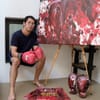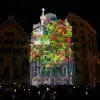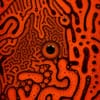Paint-crusted boxing gloves are perched on the backrest of a chair in Chulayarnnon Siriphol’s Bangkok studio. Next to the chair sits a canvas on an easel splashed in red, recalling the action paintings of Japanese artist Ushio Shinohara, who dipped boxing gloves in paint and punched at canvases.
Both are remnants of the video installation Red Eagle Sangmorakot: No More Hero in His Story, that won the Taoyuan International Art Award Grand Prize in Taiwan earlier this year.
Siriphol's work often combines performance art, using his own body as a medium, with experimental filmmaking. His films tie together magical realism, humor and mockumentary elements that draw inspiration from Thai pop culture to address social issues. Considering the country’s limits on free expression, he uses these elements as a cultural code, engaging viewers subtly while questioning societal norms and power structures.
As part of Red Eagle Sangmorakot, the artist trained for three months in traditional Muay Thai boxing at the Sangmorakot Academy in Bangkok. “The trainer taught me techniques like straight punches, uppercuts, elbows, knee strikes, kicks, push kicks, and defensive moves,” explains Siriphol. “After some time, I started to get used to the intensity of the workouts, but over three months I felt shin pain from improper kicking, abrasions from striking the heavy punching bag, bruised knees, and sore elbows.”
The training helped him to better emphasize with the boxers and get an idea of the tough training conditions. It also prepared him for his boxing-painting performance shown as one element of Red Eagle Sangmorakot, assembled as a three-channel video installation. The other two channels featured a dystopian science fiction film assembled from archive footage and an ethnographic documentary, with interviews Siriphol conducted in the Muay Thai industry. “Normally, the artist is the main creator, but for this project I collaborated closely with the curator, an anthropologist, and a boxing coach,” he adds.
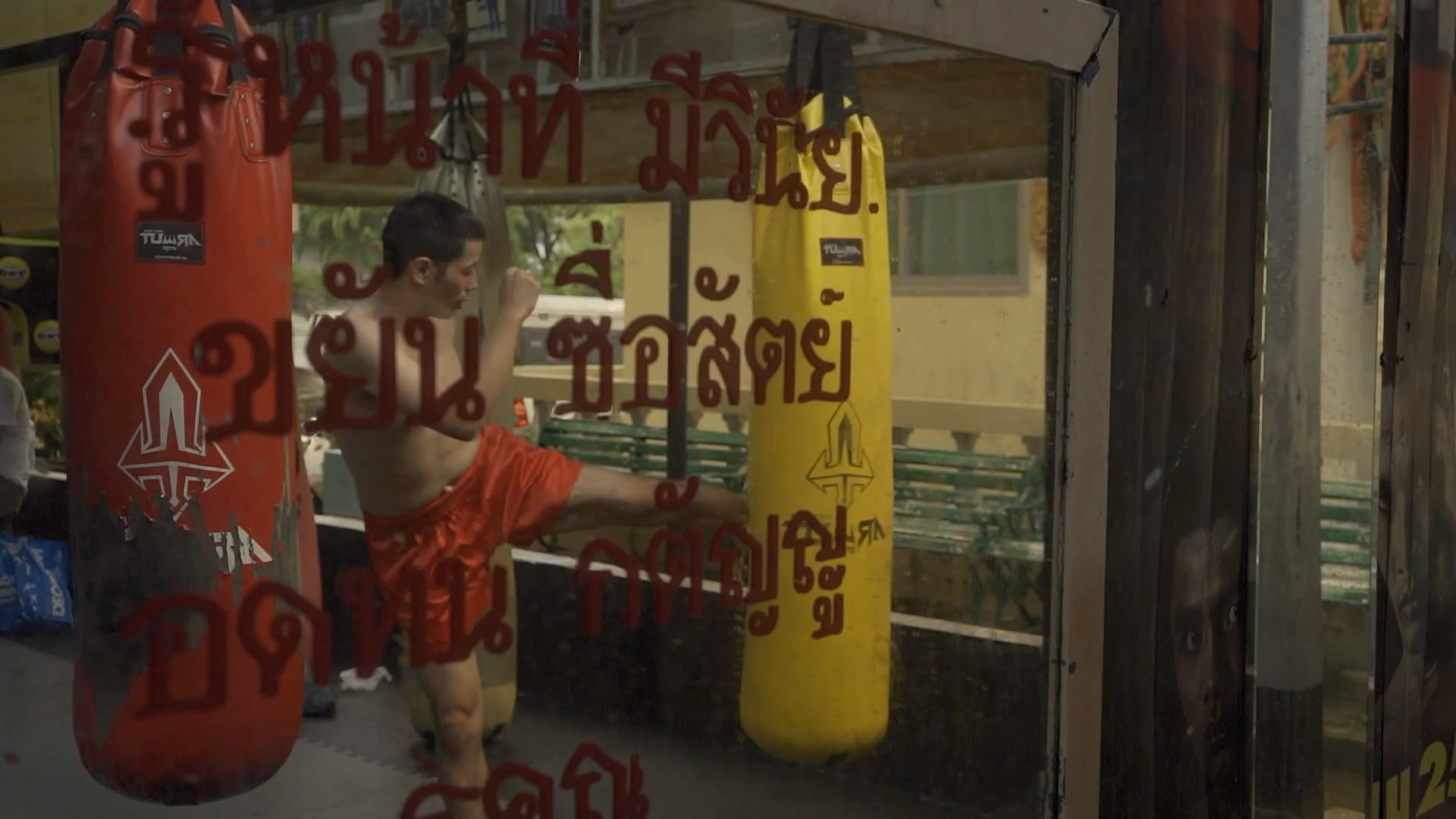
Punches, Kicks, and Elbows: Muay Thai is Pain
“In Thailand, almost all boxers come from poor, rural communities. The families often see no other way than to send their children to the boxing camp to train and fight for money,” says Siriphol. “Of course, they are too young to compete, and studies show it can affect their brain development. At my boxing camp Sangmorakot, I saw some kids who came in to train early in the morning and in the evening, but during the day they attended school like other children. In the evening, however, they trained quite hard as professional boxers, and they also fight against each other. But the fighting will not be broadcast on television because it’s officially against the law, although it’s widely accepted across Thailand, and no one would call it human trafficking or child labour.”
Thai warriors originally practiced Muay Thai on the battlefields centuries ago. It demands more from fighters than other martial arts. Punches, kicks, elbows, and knees—everything goes. Or, as former pro fighter Kru Bunpot put it: "Muay Thai is pain. You get hit with devastating attacks, get swept to oblivion, have gruelling training sessions… You either take it or quit. If you can't handle pain, you can't do Muay Thai.”
In Thai culture, Muay Thai boxers are commonly referred to as 'hunting dogs,' athletes bound to serve their 'masters,' whether gym owners, managers, or gambling patrons, by winning competitions. For those young boxers, it’s often the only way to fight their way out of poverty until they retire in their late 20s or early 30s. While some famous athletes go on to run their own training camps or work as ambassadors of the sport, many of them return to the poverty they tried to escape from.
“I wanted to show the harsh reality of Muay Thai”
“Muay Thai is an important part of Thailand's identity, and we are so proud of this sport,” says Siriphol. “The image of Thai boxing shown in the media is beautiful, patriotic, and heroic. But with this project, I wanted to show the harsh reality, which is very different from what is presented.”
Siriphol borrowed the title 'Red Eagle' from a Thai superhero film series of the 1960s during the Cold War. It was influenced by American cinema. The main character is a Thai version of Batman, an undercover police hero fighting crime and corruption, wearing a red mask that was shaped like an eagle. “Back in the day, these films were popular entertainment, but I wanted to explore them through political history. For example, in Red Eagle, the enemies look like communist leaders. So I analyze these political messages in Thai films that are disguised as entertainment.”
This interplay of politics and popular culture reached from cinema to sports. During the Cold War, Thailand served as a key U.S. ally in Southeast Asia, hosting American soldiers during the Vietnam War. Their Thai counterparts started teaching U.S. soldiers Muay Thai, which helped increase its popularity outside of Asia.
Article 29 and The Birth of Golden Snail
Siriphol tries to raise awareness of these political undercurrents and social issues in Thailand, which doesn’t come without risk. In 2018, the Ministry of Culture banned his short film Birth of Golden Snail from the Thailand Biennale in Krabi because officials said it violated Article 29 of the 2008 Film and Video Act, which covers peace, morality, national security, and Thailand’s dignity.
He based the film on the complex history of the Khao Kha Nab Nam cave in Krabi during pre-historic times and WWII, where it served Japan as a strategic shelter and base for controlling maritime routes, after Thailand agreed to ally with Japan to maintain its sovereignty. Most historians see this as a pragmatic, opportunistic response, but one that carried significant moral and political consequences.
Siriphol's film blurs the boundaries between historical fact, fiction, folktale, and fantasy, by using black-and-white 16mm film as a metaphor for early film and prehistoric shadows seen on cave walls.
The story draws inspiration from a Thai folktale about a woman who gives birth to a shell containing a boy, represented as the African Giant Snail, an alien species introduced to Thailand during World War II by Japanese soldiers as a food source. The gold element in the snail connects to a Southeast Asian myth that Japanese soldiers hid gold in the forest during the war. It is a recurring symbol in his Siriphol's work, and serves as a metaphor for the influence Japanese culture has had on his life.
“The Office of Contemporary Art and Culture, Ministry of Culture, asked me to see the film before the screening of the Thailand Biennale in Krabi in 2018. I sent the preview video link to the committee and had a meeting with them to explain the idea and concept. After my presentation, the committee asked me to re-edit and cut some scenes from the film because they were afraid of negative feedback from the local people in Krabi. I refused to censor my film, because, in case of criticism, I wanted to have an open dialogue with the public after the screening.”
Family Conflict: A Case Study
Siriphol’s work has not always been that politically charged. Earlier in his career, he mainly focused on personal themes. Everything changed with the violent 2010 military crackdown on pro-democracy protesters. “This was a turning point for me, guiding my practice into a more political direction. Politics happens not just between politicians; it’s the relationships between people, for example, the relationship between me and my family. My grandfather was a Navy ambassador in Japan, and my family is on the conservative side. They see democracy as the problem of Thailand. This created a big conflict between me and my relatives, that I also address in my work.”
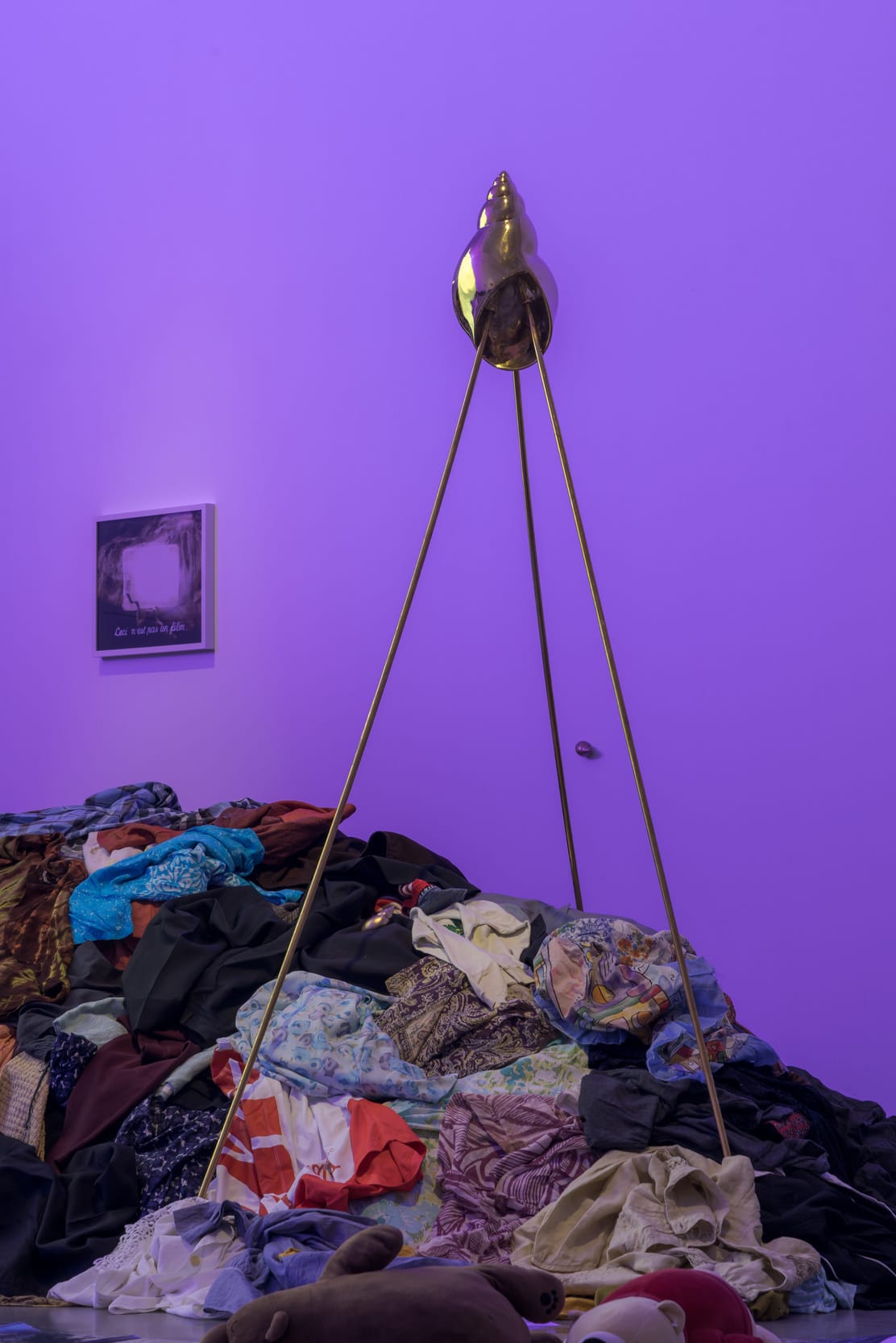
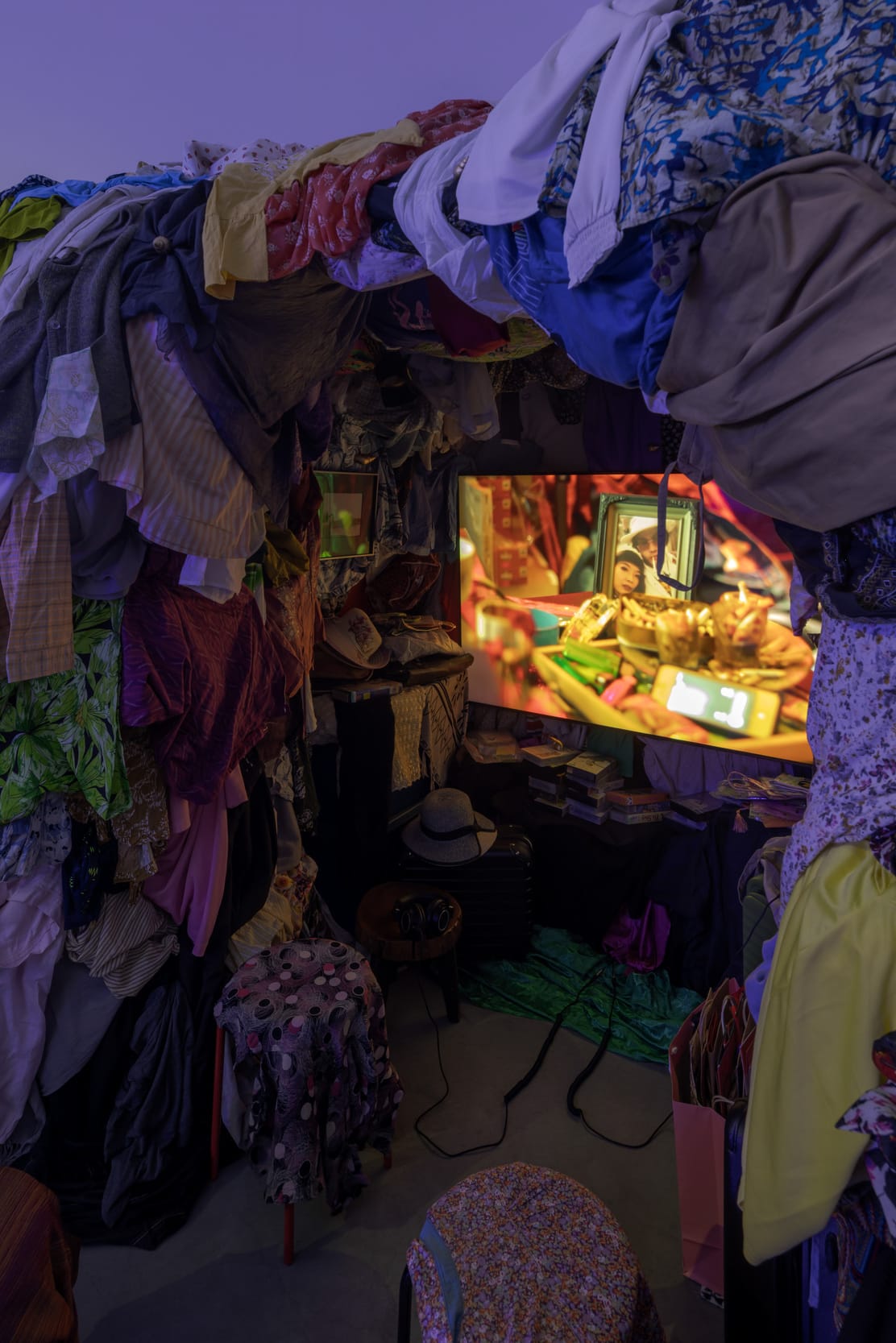
Installation view of I a Pixel, We the People at CityCity Gallery in Bangkok. Photos by Soopakorn Srisakul.
I a Pixel, We the People: A Retrospective
Siriphol sees his family's situation as a "case study" for the national divide between progressives and conservatives, that cuts through families across Thailand. The political divide in his personal life was also a central theme of his recent mini-retrospective, I a Pixel, We the People, at CityCity Gallery in Bangkok. At its core is a 24-episode video installation, which combines the artist's personal archives, family memories like home videos, footage from protests and his mother’s garments—housed in small, womb-like viewing spaces.
Siriphol structured the story of the video around the earlier mentioned recurring motif of the "golden snail," here serving as a character the artist has embodied since childhood, which evolves from personal family stories and the relationship with his mother to venturing onto the streets to protest, and experiencing defeat.
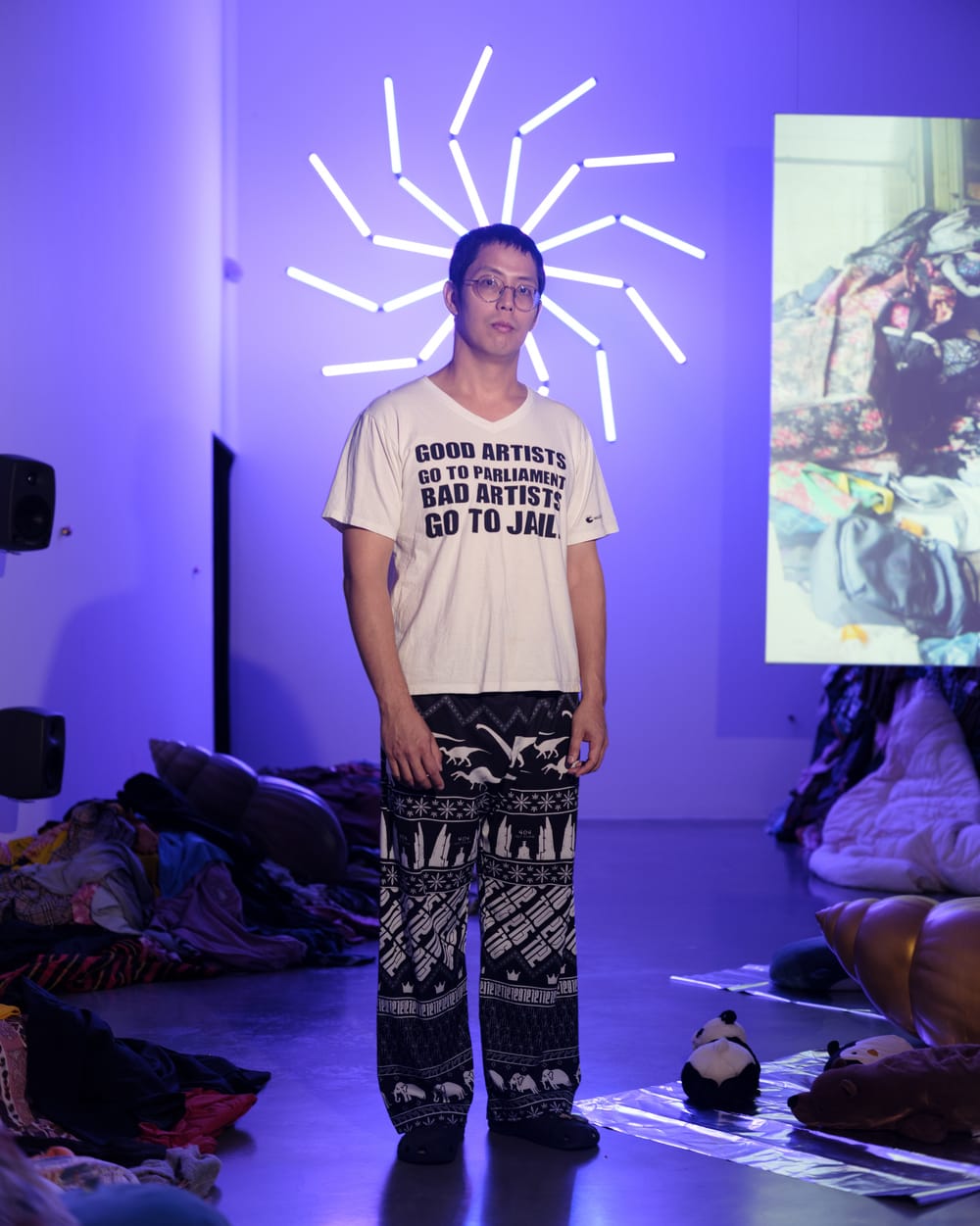
"We the people" refers to the first sentence of the American Constitution, symbolising the starting point of democracy and the belief that everyone has power to change."I a pixel" refers to the modern reality where our physical bodies are transformed and digitised into pixels through face recognition, other bio data and our activity on social media and digital platforms. “I believe this digital transformation allows people to express ideas in the digital world, and foster societal change even when physical protests might seem hopeless”, he says.
The exhibition's closing segment, "House of Tomorrow," refers to a poem by Lebanese-American writer and philosopher Kahlil Gibran about children's freedom to decide their own future. An excerpt of it reads: “Your children are not your children. They are the sons and daughters of Life’s longing for itself. They come through you but not from you, and though they are with you, yet they belong not to you. You may give them your love, but not your thoughts, for they have their own thoughts.”
The final episodes of the retrospective also address the role of contemporary art in promoting democracy, with Siriphol transforming into a "voluntary artist," wearing a boy scout uniform akin to an art labourer supporting the art ecosystem.
"I wore the uniform in junior high school because we were required to be Boy Scouts, but the Boy Scouts in Thailand aren’t the same as those in the West," Siriphol explains. "We learned basic survival skills, but the Thai Boy Scouts also have a strong organizational and civic focus, with certain values and ideologies built into the program.
When I was young, I didn’t just learn survival skills in the forest—I also absorbed these ideas through the Boy Scouts. I drew on this experience when creating characters in my films, imagining them as a people’s army, but in my version, they fight for contemporary art.
Sometimes I feel like I work as an artist for free, or on very low budgets. In that sense, I’m like a Boy Scout: a voluntary artist working to improve the art ecosystem in Thailand. It’s a little sarcastic, but I embrace it."
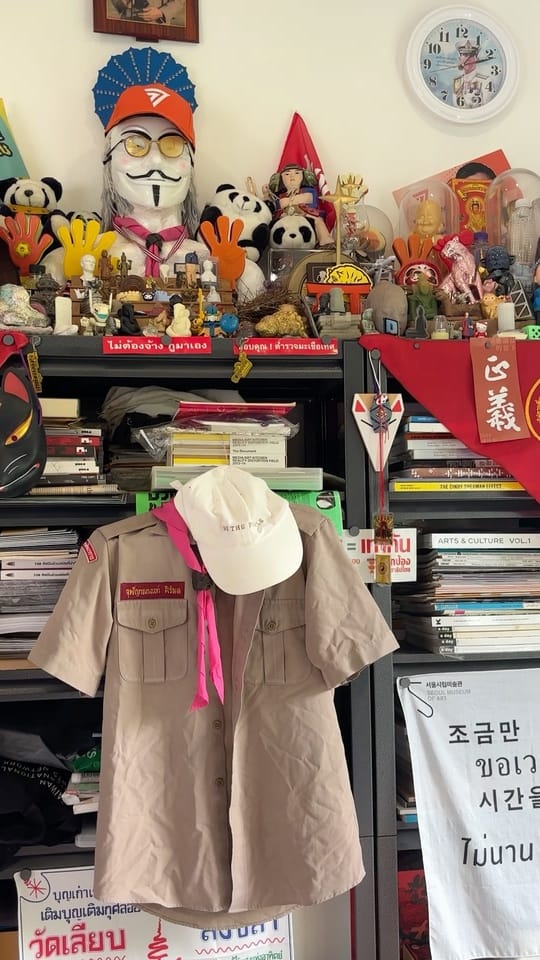
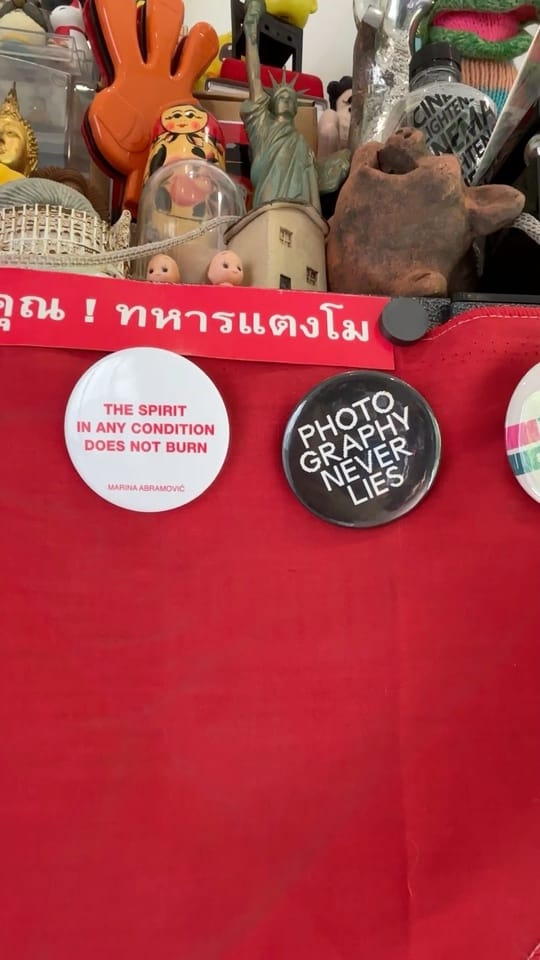
Details from his studio: Among them the boy scout uniform Siriphol wore in high school.
This exact boy scout uniform now decorates his studio’s bookshelf, which is filled with art magazines, alongside a collection of souvenirs, figurines, and trinkets that blend political messages with cultural symbols including a Matryoshka doll, a lucky cat, a tiny Statue of Liberty, a Buddha, various rubber ducks, a disposable camera, and other curiosities.
“This is my shrine of belief,” he says, reaching up for a toy shaped like a three-fingered plastic hand. He starts shaking it and explains: “We used this during the pro-democracy student protests in 2020 and 2021. As you can hear, it makes noise when you shake it, so you wouldn’t have to keep clapping your hands throughout the demonstration, which can be tiring after a while. The three fingers are a gesture originally from the sci-fi film series Hunger Games, where it was a sign of resistance against an authoritarian regime.”


